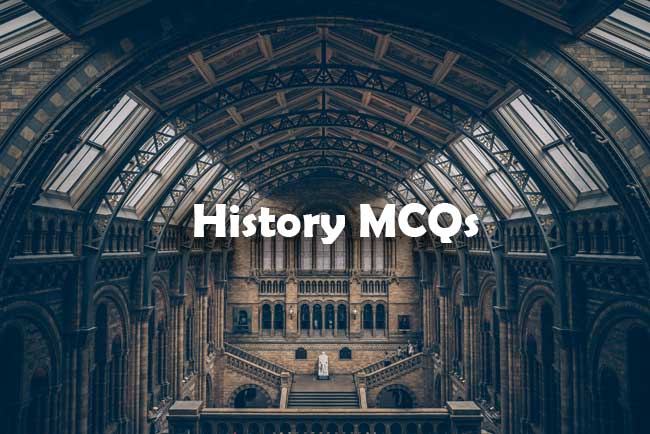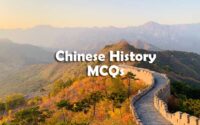History GK
History GK Questions and Answers papers are available here to download. This is the good news for the candidates who are preparing for history General Knowledge. Aspirants can download history GK pdf through online mode.

Applicants who are preparing for history GK can download history GK Sample questions from our website for free. Aspirants who are seeking for history General Knowledge Sample Question Papers, for those candidates our site is the useful platform to get history GK questions Papers.
With this history General Knowledge Papers, candidates can easily prepare for the exam. You can check these history GK and get an idea about model questions given in the written test.
GK of History
1. Which one of the following is the Samhita of white yajurveda?
(A) Katha
(B) Maitrayani
(C) Taittiriya
(D) Vajasaneyi
2. King Asvapati of the upanishadic age was the ruler of
(A) Kekaya
(B) Madra
(C) Panchala
(D) Usinara
3. The maximum number of kingdoms of the group of sixteen Mahajanapadas are to be located in
(A) Bihar
(B) Uttar Pradesh
(C) Madhya Pradesh
(D) Punjab
4. “It is the job of laity than the job of marks to worship the corporeal remains of the Buddha“. This statement is made in the Mahaparinibbana Sutta by
(A) Ananda
(B) Gautama Buddha
(C) Mahakassapa
(D) Subhadra
5. Which of the following was a land measure?
(A) Adhaka
(B) Dharaka
(C) Karsha
(D) Nivartana
6. Tulamaya, a contemporary king of Asoka was the ruler of
(A) Syria
(B) Egypt
(C) Corinth
(D) Macedonia
7. Who among the following was a lady Alwar saint?
(A) Andal
(B) Madhur Kavi
(C) Perumal
(D) Tirupan
8. Which one of the following pairs represents the mint centre of the Yaudheyas?
(A) Agaroha, Bayana
(B) Bayana, Rohtak
(C) Rohtak, Sunet
(D) Sunet, Agaroha
9. Who among the following Gupta ruler was known by another name Devagupta?
(A) Chandraguptal
(B) Samudragupla
(C) Chandragupta II
(D) Kumaragupta
10. Who among the following assumed the title Paramasaugata?
(A) Bhaskaravarman
(B) Sasanka
(C) Rajyavardhana
(D) Harsha
11. Which of the following Mamallapuram Rathas is apsidal in plan?
(A) Arjuna Ratha
(B) Bhima Ratha
(C) Dharmaraja Ratha
(D) Nakula-Sahadeva Ratha
12. Who among the following was the ruler of the Chola Country at the time of Mahmud Ghazni’s expedition of Gujarat?
(A) Uttama Chola
(B) Rajarajal
(C) Rajendral
(D) Kolottungal
13. Who made Jizyah a separate tax from land revenue?
(A) Iltutmish
(B) Alauddin Khilji
(C) Balban
(D) Firuz Tuglag
14. Which of the following represents the correct chronological order of events concerning Mahmud of Ghazni?
(A) Fall of Bhatinda— Capture of Sistan— Annexation of Multan— First defeat of Anandpal
(B) Capture of Sistan— First defeat of Anandpal— Fall of Bhatinda— Annexation of Multan
(C) Capture of Sistan— Fall of Bhatinda— First defeat of Anandpal— Annexation of Multan
(D) Fall of Bhatinda— Firstdefeat of Anandpal— Annexation of Multan— Cupture of Sistan
15. Which one of the following is not correctly matched?
(A) Chachar : Land out of cultivation for three / four years
(B) Paitaqi : Land reserved for allotment in jagir
(C) Rahdari : Protection money paid by travellers
(D) Wahdot-al-Wajud Official title of Muslim preacher
16. Who among the following said that in India there was no middle class; a person was either extremely rich or lived miserably?
(A) Amir Khusrau
(B) Iban Battuta
(C) Bernier
(D) Abul Fazal
17. Which one of these is not correct?
(A) Nadia was the centre of Vedantic nationalism.
(B) Nanak had no intention of founding a new religion.
(C) Kabir was the first saint to substitute the worship of Vishnu by Ram.
(D) Ibn-i-Arabi was popular among broad sections of India during the fifteenth century.
18. Who among these patronized by the king Akbar has been hailed as “the most accomplished man of his day in the science of music and in Hindi song”?
(A) Baz Bahadur of Malwa
(B) Tansen
(C) Birbal
(D) Abdur Rahim Khankhanan
19. Which one of these commercial classes was specialised in local retail trade?
(A) Modi
(B) Bohra
(C) Seth
(D) Banik
20. Abdur Razaq visited Vijayanagar Empire during the reign of
(A) Harihara II
(B) Devaraya II
(C) Narsa Nayak
(D) Krishna Deva Raya
| MCQ | Hard Questions |
| GK | Basic Questions |
| Quiz | Trivia |
| Easy Questions |
21. The term diwan-i-tan denotes
(A) Chief Imperial Fiscal officer
(B) Officer responsible for payment of Mansabdars
(C) Officer in charge of the land
(D) Officer in charge of a fixed territory
22. Which of the following statements is not correct concerning education and learning during the Mughal period?
(A) Construction of educational institutions under Babur was assigned to Shuhrat-i-Am.
(B) Humayun’ s favourite subjects of study were geography and astronomy.
(C) Akbar’s attempt of providing education to Hindu pupils in Madrasas was not prompted by his policy of religious toleration.
(D) Jahangir after his accession took immediate steps for repair of many Madrasas which had been fallen into swelling places of birds and beasts.
23. Who under Shivaji looked after the foreign affairs?
(A) Sachiva
(B) Samanta
(C) Mantri
(D) Amatya
24. Who has described the historiography of Indian nationalism as ‘blinkered historiography’?
(A) Bipin Chandra
(B) Ranajit Guha
(C) Partha Chatterjee
(D) Sekhar Bandyopadhyay
25. The Sanyasi rebellions of the late eighteenth century were led by
(A) Vaisnavite Goswamis
(B) Dasnami Gurus
(C) Tantriks
(D) Saivites
26. Which historian has commented “there is nothing in the militant movements of – – rural masses that was not political”?
(A) Ranajit Guha
(B) Sumit Sarkar
(C) Barun De
(D) Irfan Habib
27. Why was Lord Canning often referred to as ‘Clemency Canning‘?
(A) For being lenient to the prisoners
(B) For pardoning the offenders
(C) For pardoning the rebellious sepoys
(D) For being lenient to the patriotic Indians
28. Bharatendu Harischandra claimed High Status and antiquity for Hindu based on
(A) Perso-Arabic tradition
(B) Urdu tradition
(C) Classical Sanskrit tradition
(D) Local and popular traditions
29. Who wrote the biography of Allen Octavian Hume published in 1913?
(A) William Wedderhurn
(B) Valentine Chirol
(C) Lord Ripon
(D) Lord Hardinge
30. In his Swadeshi Samaj Address, Rabindranath Tagore emphasised on
(A) rural reconstruction
(B) literary drives
(C) self help or atma sakti
(D) social welfare
31. Which Indian social theorist has stressed that Indian intelligentsia remained within two domains of action the material and spiritual?
(A) Partha Chatterjee
(B) Dipesh Chakraborty
(C) Syam Prakash
(D) Malavika Karlekar
32. What activities were indulged by the peasants in the name of the tradition of ‘dhandak’ in Tehri Garhwal?
(A) Burning down the houses of the landlords
(B) Destroying the law courts
(C) Protesting the tyranny of the officials and seeking the justice from the sovereign
(D) Killing government officials
33. Who among the Indian Capitalists had demanded that “all British investments in India be expatriated”?
(A) Purushottamdas Thakurdas
(B) Jamnala Bajaj
(C) G.D.Birla
(D) Walchand Hirachand
34. The All State People‘s Conference (1927) was founded in
(A) Delhi
(B) Madras
(C) Bombay
(D) Trivandrum
35. The Irwin Offer of l929 proposed
(A) Round Table Conference to settle the problems of dominion status
(B) All Party Conference to decide on issues related to electoral representatives
(C) Meeting of the Congress leaders to resolve the caste issues
(D) Meeting of Hindu and Muslim leaders to eliminate communalism
| Ancient India | Modern India |
| Medieval India | World History |
36. Who among the following had identified the Congress in post independent India as the dominant party system?
(A) Rajni Kothari
(B) Stanley Kochanek
(C) Partha Chatterjee
(D) Paul Brass
37. Which historian had observed, “The Bosnian crisis first showed to Europe the shadow of a general War”?
(A) A J P Taylor
(B) F. Markham
(C) David Thomson
(D) M.M.Postan


